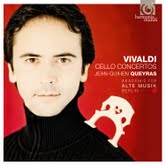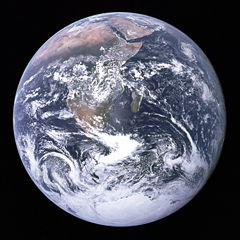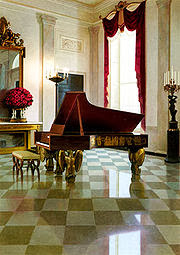In review--Venetian Cello to Woo You
Akademie Für Alte Musik Berlin
Vivaldi Cello Concertos
Harmonia Mundi
Vivaldi Cello Concertos
Harmonia Mundi
I’ve never been a huge fan of the Venetian composer Antonio Vivaldi’s repertoire. I heard it grace several music soundtracks growing up, heard The Four Seasons at weddings, on street corners, farmer’s markets and cafes, mostly in passing. I only own one other Vivaldi recording, featuring a Norwegian girl’s choir singing sacred works on Kirkelig Kulturverksted. But Vivaldi’s cello concertos have the power to win me over and to transform the cello’s melancholic reputation. Many of us are familiar with the expressive cello as portrayed in Bach’s (a baroque contemporary of Vivaldi) cello suites, but during the baroque era, the cello’s role was to contribute a continuous bass along with bassoon and other low-end instruments. This means that innovative Vivaldi went against the musical protocol of his time, when he transformed the cello into a lead player. The results are spectacular. Forget the Four Seasons, (though splendid), and give me the cello concertos. (BTW, while Vivaldi's cello concertos were performed during his day, Bach's cello suites were not).
According to the liner notes of Jean-Guihen Queyras and Akademie Für Alte Musik Berlin’s Vivaldi Cello Concertos, Vivaldi who was employed at a girl’s orphanage to teach the girls music, composed 27 cello concertos, and 7 of those concertos appear on this recording, along with 2 symphonies by Vivaldi’s contemporary Venetian Antonio Caldara and one symphony (Sinfonia in C major) by Vivaldi. For the sake of this review, I’m only reviewing Vivaldi’s work that appears on the disk. I recommend buying the recording to experience the full musical effect. And just as Mozart’s music has been touted for its healing power, let’s not disregard Vivaldi’s music. I listened to this recording with headphones and contemplated different parts of my brain lighting up, as if I was hooked to a MRI. I certainly felt my moods shifting with each movement of the concertos.
The recording opens with Vivaldi’s Sinfonia in C major which doesn’t mince notes. In fact, I think this is one of the most powerful openings of classical work I’ve heard in a long time. The orchestra with its fast runs reminds me of rabbit darting up and down stairs, and then darting off into the distance. I’m not sure why this image popped into my head, but music often brings me vibrant images, which is no exception with this recording. Vivaldi’s work here features surprises and innovations (such a bowing techniques and agility required on the cellist's part), that still feel provocative in the modern world. I think too that Queyras’ expressive cello and his interpretations along with the expertise of the German baroque orchestra play large roles in creating this excitement. A virtuoso cellist has the power to grab our attention and keep it for the duration of a performance—think Yo-Yo Ma for instance.
For instance, Concerto for Cello and Bassoon in E minor features one of Vivaldi’s innovations. On the first movement, Adagio/Allegro molto, the cello plays slow moody passages while the orchestra contrasts with quick runs. On the second movement the opposite effect occurs and by the third movement the cello and orchestra are back in tandem. And while I didn’t take notes for the closing concerto (in A minor), I found the concerto charming and vivacious; the perfect concerto to end the program. Overall, I feel impressed with this recording and feel that I will listen to it often in the future, despite all the choices in my music library. I believe strongly that music has the power to heal us and the planet, and this recording with its slow pastoral movements alternating with feisty ones, gets us off to a good start.




Comments
Post a Comment